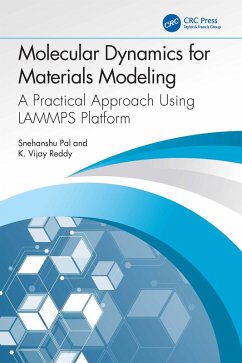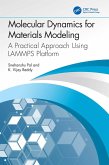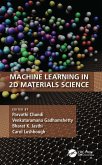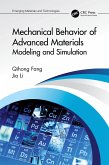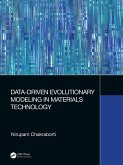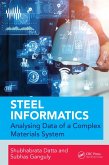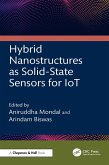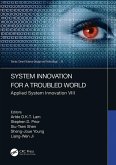Snehanshu Pal, K. Vijay Reddy
Molecular Dynamics for Materials Modeling (eBook, ePUB)
A Practical Approach Using LAMMPS Platform
52,95 €
52,95 €
inkl. MwSt.
Sofort per Download lieferbar

26 °P sammeln
52,95 €
Als Download kaufen

52,95 €
inkl. MwSt.
Sofort per Download lieferbar

26 °P sammeln
Jetzt verschenken
Alle Infos zum eBook verschenken
52,95 €
inkl. MwSt.
Sofort per Download lieferbar
Alle Infos zum eBook verschenken

26 °P sammeln
Snehanshu Pal, K. Vijay Reddy
Molecular Dynamics for Materials Modeling (eBook, ePUB)
A Practical Approach Using LAMMPS Platform
- Format: ePub
- Merkliste
- Auf die Merkliste
- Bewerten Bewerten
- Teilen
- Produkt teilen
- Produkterinnerung
- Produkterinnerung

Bitte loggen Sie sich zunächst in Ihr Kundenkonto ein oder registrieren Sie sich bei
bücher.de, um das eBook-Abo tolino select nutzen zu können.
Hier können Sie sich einloggen
Hier können Sie sich einloggen
Sie sind bereits eingeloggt. Klicken Sie auf 2. tolino select Abo, um fortzufahren.

Bitte loggen Sie sich zunächst in Ihr Kundenkonto ein oder registrieren Sie sich bei bücher.de, um das eBook-Abo tolino select nutzen zu können.
The book focuses on correlation of mechanical behavior with structural evaluation and the underlying mechanism through molecular dynamics technique using Large-scale Atomic/Molecular Massively Parallel Simulator (LAMMPS) platform. It also gives idea about the architecture of the coding used in LAMMPS and basic information about the syntax.
- Geräte: eReader
- mit Kopierschutz
- eBook Hilfe
Andere Kunden interessierten sich auch für
![Molecular Dynamics for Materials Modeling (eBook, PDF) Molecular Dynamics for Materials Modeling (eBook, PDF)]() Snehanshu PalMolecular Dynamics for Materials Modeling (eBook, PDF)52,95 €
Snehanshu PalMolecular Dynamics for Materials Modeling (eBook, PDF)52,95 €![Machine Learning in 2D Materials Science (eBook, ePUB) Machine Learning in 2D Materials Science (eBook, ePUB)]() Machine Learning in 2D Materials Science (eBook, ePUB)130,95 €
Machine Learning in 2D Materials Science (eBook, ePUB)130,95 €![Mechanical Behavior of Advanced Materials: Modeling and Simulation (eBook, ePUB) Mechanical Behavior of Advanced Materials: Modeling and Simulation (eBook, ePUB)]() Qihong FangMechanical Behavior of Advanced Materials: Modeling and Simulation (eBook, ePUB)52,95 €
Qihong FangMechanical Behavior of Advanced Materials: Modeling and Simulation (eBook, ePUB)52,95 €![Data-Driven Evolutionary Modeling in Materials Technology (eBook, ePUB) Data-Driven Evolutionary Modeling in Materials Technology (eBook, ePUB)]() Nirupam ChakrabortiData-Driven Evolutionary Modeling in Materials Technology (eBook, ePUB)58,95 €
Nirupam ChakrabortiData-Driven Evolutionary Modeling in Materials Technology (eBook, ePUB)58,95 €![Steel Informatics (eBook, ePUB) Steel Informatics (eBook, ePUB)]() Shubhabrata DattaSteel Informatics (eBook, ePUB)54,95 €
Shubhabrata DattaSteel Informatics (eBook, ePUB)54,95 €![Hybrid Nanostructures as Solid-State Sensors for IoT (eBook, ePUB) Hybrid Nanostructures as Solid-State Sensors for IoT (eBook, ePUB)]() Hybrid Nanostructures as Solid-State Sensors for IoT (eBook, ePUB)52,95 €
Hybrid Nanostructures as Solid-State Sensors for IoT (eBook, ePUB)52,95 €![System Innovation for a Troubled World (eBook, ePUB) System Innovation for a Troubled World (eBook, ePUB)]() System Innovation for a Troubled World (eBook, ePUB)52,95 €
System Innovation for a Troubled World (eBook, ePUB)52,95 €-
-
-
The book focuses on correlation of mechanical behavior with structural evaluation and the underlying mechanism through molecular dynamics technique using Large-scale Atomic/Molecular Massively Parallel Simulator (LAMMPS) platform. It also gives idea about the architecture of the coding used in LAMMPS and basic information about the syntax.
Dieser Download kann aus rechtlichen Gründen nur mit Rechnungsadresse in A, B, BG, CY, CZ, D, DK, EW, E, FIN, F, GR, HR, H, IRL, I, LT, L, LR, M, NL, PL, P, R, S, SLO, SK ausgeliefert werden.
Produktdetails
- Produktdetails
- Verlag: Taylor & Francis eBooks
- Seitenzahl: 200
- Erscheinungstermin: 27. März 2024
- Englisch
- ISBN-13: 9781003859413
- Artikelnr.: 69854635
- Verlag: Taylor & Francis eBooks
- Seitenzahl: 200
- Erscheinungstermin: 27. März 2024
- Englisch
- ISBN-13: 9781003859413
- Artikelnr.: 69854635
- Herstellerkennzeichnung Die Herstellerinformationen sind derzeit nicht verfügbar.
Snehanshu Pal is presently working as an associate professor in the Department of Metallurgy and Materials Engineering, Indian Institute of Engineering Science and Technology, Shibpur, West Bengal, India. He previously worked at the National Institute of Technology (NIT), Rourkela, India for nine years (2014-2023). He has served as a postdoctoral fellow in the Department of Materials Science and Engineering, the Pennsylvania State University. He received his PhD in metallurgical and materials engineering from the Indian Institute of Technology, Kharagpur, India, in 2013. A-passionate researcher, critical thinker, and committed academician, Snehanshu Pal currently holds an assistant professor position at the Metallurgical and Materials Engineering Department of NIT, Rourkela, since 2014. His research focuses on the study of the deformation behavior of nanostructured material using MD simulation and modeling of metallurgical processes. He is eager to teach and pass on knowledge and is a highly motivated, reliable, dedicated, innovative, and student-oriented teacher in the elds of mechanical metallurgy, metallurgical thermodynamics, and atomistic modeling of materials.
Snehanshu Pal leads the Computational Materials Engineering and Process Modeling Research Group at NIT, Rourkela, a group dedicated to realizing the underlying physics behind the mechanical behavior of materials and simulating metallurgical processes (http://www.snehanshuresearchlab.org). He has published more than 100 high-impact research articles in internationally reputed journals. He has supervised three doctoral theses and several master's theses. He is an investigator of numerous sponsored research projects and industrial projects. He has active research collaborations with esteemed universities across the globe (such as the University of Florida, the University of Manitoba, Université Lille, and the National Academy of Science of Belarus). In addition, Snehanshu Pal is associated with various esteemed technical and scientific societies such as the Indian Institute of Metals and Indian Institute of Engineers.
K. Vijay Reddy is a postdoctoral researcher in KU Leuven, Belgium, working primarily in the eld of computational materials engineering. He did his PhD at the Department of Metallurgical and Materials Engineering, National Institute of Technology (NIT), Rourkela, India, working on nanoscale behavior of materials and design of nano-processing techniques using atomistic simulation techniques. His doctoral research focuses on investigating the material processing of nanoscale metallic systems using molecular dynamics simulation processes. Apart from the doctoral research eld, he has worked on multiple research projects and published more than 30 research articles in high-quality journals over the years. He has demonstrated a strong command of computational skills, has been involved in developing many in-house simulation codes, and has gathered vast knowledge from all of his research experiences. Together with Dr. Snehanshu Pal, he has also been associated with various collaborations with esteemed universities across the globe (such as the University of Florida, University of Manitoba, and University of California Irvine). Apart from atomistic simulations, he has also worked with industrial collaborator Dr. Chandan Halder (manager, Mishra Dhatu Nigam Limited) in the eld of microstructure modeling. Vijay Reddy is an integral part of the Computational Materials Engineering and Process Modeling Research Group that is led by Dr. Snehanshu Pal at the National Institute of Technology, Rourkela, a group dedicated to realizing the underlying physics behind the mechanical behavior and processing of materials and simulating metallurgical processes (http://www.snehanshuresearchlab.org).
Snehanshu Pal leads the Computational Materials Engineering and Process Modeling Research Group at NIT, Rourkela, a group dedicated to realizing the underlying physics behind the mechanical behavior of materials and simulating metallurgical processes (http://www.snehanshuresearchlab.org). He has published more than 100 high-impact research articles in internationally reputed journals. He has supervised three doctoral theses and several master's theses. He is an investigator of numerous sponsored research projects and industrial projects. He has active research collaborations with esteemed universities across the globe (such as the University of Florida, the University of Manitoba, Université Lille, and the National Academy of Science of Belarus). In addition, Snehanshu Pal is associated with various esteemed technical and scientific societies such as the Indian Institute of Metals and Indian Institute of Engineers.
K. Vijay Reddy is a postdoctoral researcher in KU Leuven, Belgium, working primarily in the eld of computational materials engineering. He did his PhD at the Department of Metallurgical and Materials Engineering, National Institute of Technology (NIT), Rourkela, India, working on nanoscale behavior of materials and design of nano-processing techniques using atomistic simulation techniques. His doctoral research focuses on investigating the material processing of nanoscale metallic systems using molecular dynamics simulation processes. Apart from the doctoral research eld, he has worked on multiple research projects and published more than 30 research articles in high-quality journals over the years. He has demonstrated a strong command of computational skills, has been involved in developing many in-house simulation codes, and has gathered vast knowledge from all of his research experiences. Together with Dr. Snehanshu Pal, he has also been associated with various collaborations with esteemed universities across the globe (such as the University of Florida, University of Manitoba, and University of California Irvine). Apart from atomistic simulations, he has also worked with industrial collaborator Dr. Chandan Halder (manager, Mishra Dhatu Nigam Limited) in the eld of microstructure modeling. Vijay Reddy is an integral part of the Computational Materials Engineering and Process Modeling Research Group that is led by Dr. Snehanshu Pal at the National Institute of Technology, Rourkela, a group dedicated to realizing the underlying physics behind the mechanical behavior and processing of materials and simulating metallurgical processes (http://www.snehanshuresearchlab.org).
Chapter 1. Atomistic simulation: A theoretical understanding. 1.1 Introduction. 1.2 General steps of MD simulation. 1.3 Interatomic potentials. 1.4 Concept of ensembles. 1.5 Boundary conditions. 1.6 Architecture of LAMMPS input file. 1.7 Post-processing analysis using LAMMPS. Chapter 2. Physical properties evaluation by MD simulation. 2.1 Preparation of nanoscale samples. 2.2 Physical properties in nanoscale metals. 2.3 Evaluation of mechanical properties. 2.4 Evaluation of thermal properties. Chapter 3. Nanoscale simulation of deformation behavior. 3.1 Scale-dependent deformation behavior. 3.2 Deformation simulation of dynamic loading. 3.3 Deformation simulation of static loading. 3.4 Deformation simulation of impact and cyclic loading. 3.5 Example LAMMPS input codes. Chapter 4. MD simulation of metallic glass. 4.1 Introduction to Metallic glasses. 4.2 Importance of MD in MG studies. 4.3 Designing metallic glasses using MD simulation in LAMMPS. 4.4 Voronoi tessellation method. 4.5 Evaluation of physical properties of MG. 4.6 Example LAMMPS input codes. Chapter 5. Grain boundary engineering using MD simulation. 5.1 Interfaces in metals and their importance. 5.2 Types of grain boundaries and interfaces. 5.3 Grain boundary engineering. 5.4 Designing and analyzing metallic GBs using LAMMPS. 5.5 Example LAMMPS input codes. Chapter 6. MD simulation of composite material. 6.1 Importance of nanoscale composite structure. 6.2 MD simulation of deformation behavior in metal matric composites. 6.3 Designing of composite materials using LAMMPS. 6.4 Evaluation of deformation behavior and mechanical properties. 6.5 Example LAMMPS input code. Chapter 7. Material processing using MD simulation: Nanoscale rolling process. 7.1 Material processing of nanostructured materials. 7.2 Nanoscale rolling process. 7.3 Design of rolling process using LAMMPS. 7.4 Example LAMMPS input code. References.
Chapter 1. Atomistic simulation: A theoretical understanding. 1.1 Introduction. 1.2 General steps of MD simulation. 1.3 Interatomic potentials. 1.4 Concept of ensembles. 1.5 Boundary conditions. 1.6 Architecture of LAMMPS input file. 1.7 Post-processing analysis using LAMMPS. Chapter 2. Physical properties evaluation by MD simulation. 2.1 Preparation of nanoscale samples. 2.2 Physical properties in nanoscale metals. 2.3 Evaluation of mechanical properties. 2.4 Evaluation of thermal properties. Chapter 3. Nanoscale simulation of deformation behavior. 3.1 Scale-dependent deformation behavior. 3.2 Deformation simulation of dynamic loading. 3.3 Deformation simulation of static loading. 3.4 Deformation simulation of impact and cyclic loading. 3.5 Example LAMMPS input codes. Chapter 4. MD simulation of metallic glass. 4.1 Introduction to Metallic glasses. 4.2 Importance of MD in MG studies. 4.3 Designing metallic glasses using MD simulation in LAMMPS. 4.4 Voronoi tessellation method. 4.5 Evaluation of physical properties of MG. 4.6 Example LAMMPS input codes. Chapter 5. Grain boundary engineering using MD simulation. 5.1 Interfaces in metals and their importance. 5.2 Types of grain boundaries and interfaces. 5.3 Grain boundary engineering. 5.4 Designing and analyzing metallic GBs using LAMMPS. 5.5 Example LAMMPS input codes. Chapter 6. MD simulation of composite material. 6.1 Importance of nanoscale composite structure. 6.2 MD simulation of deformation behavior in metal matric composites. 6.3 Designing of composite materials using LAMMPS. 6.4 Evaluation of deformation behavior and mechanical properties. 6.5 Example LAMMPS input code. Chapter 7. Material processing using MD simulation: Nanoscale rolling process. 7.1 Material processing of nanostructured materials. 7.2 Nanoscale rolling process. 7.3 Design of rolling process using LAMMPS. 7.4 Example LAMMPS input code. References.
